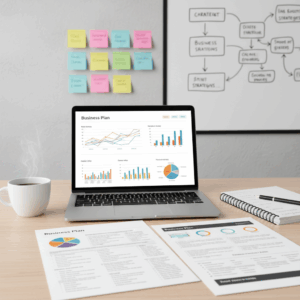Strategies for adaptation and risk control
In times of economic crisis, implement flexible strategies It is vital for companies to adapt and control the risks that threaten their financial stability.
Careful planning and constant evaluation of each action help minimize losses and identify opportunities before the competition, ensuring business continuity.
These strategies should focus on prevention and rapid response to unexpected changes in the market or the global economy.
Careful analysis of investments and decisions
A detailed analysis of investments allows you to identify which ones are truly necessary and which can be postponed, avoiding unnecessary expenses that jeopardize liquidity.
It's important to assess the risk associated with each decision, considering economic variables and market trends, and then take action based on reliable data.
This approach reduces uncertainty and strengthens the ability to react to potential negative impacts that may arise during the crisis.
Diversification of products and services
Diversification offers significant protection by expanding revenue sources and reducing dependence on a single product or market segment.
By adapting its offering to new demands or niches, the company can maintain its relevance and even discover growth opportunities in sectors less affected by the crisis.
This strategy also facilitates internal motivation and constant innovation, key to overcoming adverse periods and achieving a better position.
Optimization of resources and finances
Optimizing resources and finances is essential for businesses to maintain stability during an economic crisis, maximizing every expense and minimizing losses.
Strict control of operating and administrative costs frees up resources that can be redirected to more strategic and productive areas of the business.
Furthermore, having efficient processes and appropriate technological tools boosts performance without increasing the financial burden, strengthening competitiveness.
Reduction of operating and administrative expenses
Reducing unnecessary expenses is a key step to increasing profitability and ensuring liquidity in difficult times, prioritizing only essential areas for the business.
Constant review of contracts, internal processes, and suppliers helps identify savings opportunities without sacrificing quality or efficiency.
Implementing measures such as reducing energy consumption or renegotiating rents also contributes to reducing the cost structure.
Use of technology and automation
The incorporation of technology and automation reduces workload and errors, generating significant savings in resource and time management.
Digital tools allow you to optimize administrative tasks, improve communication, and accelerate production processes, increasing overall productivity.
Furthermore, investing in technological solutions can be a competitive advantage that facilitates adaptability to market changes and new challenges.
Emergency fund and detailed budget
Having an emergency fund is essential to deal with unexpected financial events without compromising the company's daily operations.
A detailed budget allows you to accurately plan expenses, control deviations, and make informed decisions that contribute to business survival.
This financial discipline also helps identify areas for improvement and quickly adjust to changes in the economic environment, maintaining balance.
Collaboration and customer focus
Collaboration and customer focus are fundamental pillars for companies to overcome an economic crisis. Building strong, close relationships improves resilience.
Understanding and addressing customer needs allows you to adapt products and services, generating loyalty and ensuring consistent revenue in difficult times.
Fostering strategic alliances and a culture of personalized service strengthens competitiveness and drives long-term, sustainable growth.
Strategic alliances for competitive advantage
Creating strategic alliances with other companies allows for the sharing of resources and knowledge, enhancing the capacity to innovate and respond to crises.
These collaborations generate synergies that help reduce costs, expand offerings, and access new markets with lower risk.
Cooperation based on common goals strengthens the sector's position and improves resilience to economic fluctuations.
Loyalty programs and personalized attention
Implementing loyalty programs strengthens customer relationships, ensuring their return and generating stable revenue for the company.
Personalized service improves the customer experience, increasing satisfaction and facilitating word-of-mouth recommendations, which is key in times of crisis.
These strategies help create a solid base of loyal customers that sustain the business in the face of economic difficulties.
Employee training and development
Investing in employee training and development improves their skills and motivates a more efficient and engaged team during the crisis.
Trained personnel can better adapt to market changes and contribute innovative ideas to overcome obstacles.
Strengthening internal talent is an investment that increases productivity and provides greater business stability during difficult times.
Business innovation and reinvention
During an economic crisis, innovation becomes essential for businesses not only to survive, but also to adapt and thrive under adverse conditions.
Reinventing your business model allows you to discover new ways to generate value, improve the customer experience, and differentiate yourself in a competitive market.
This dynamic process requires openness to change, creativity, and a clear focus on the opportunities that arise amidst uncertainty.
Taking advantage of the crisis to innovate
The economic crisis is driving companies to seek creative solutions and adopt technologies that improve processes and reduce costs, fostering continuous innovation.
This challenging environment also stimulates the generation of disruptive ideas that can transform products, services, or operating methods to better meet new needs.
Innovation in difficult times strengthens organizational resilience and positions the company for a faster and more sustained recovery.
Reinventing the business model
Business reinvention involves reviewing and modifying the way value is created, delivered, and captured, adapting to market and consumer changes.
This may include supply chain adjustments, new sales channels, strategic alliances, or the implementation of digital models that respond to current realities.
A reinvented model increases flexibility and competitiveness, allowing the company to overcome the crisis more effectively and take advantage of emerging opportunities.






